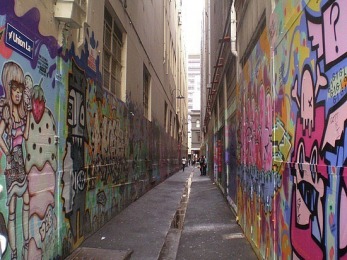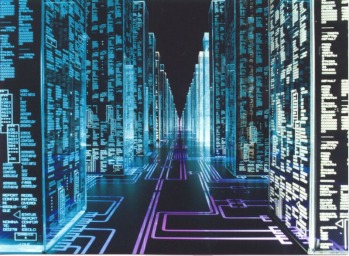digital graffiti: conventions
- Conventions are generally "a set of agreed, stipulated or generally accepted standards, norms, social norms or criteria, often taking the form of (unwritten) customs in a community."
- Even though graffiti on digital spaces exists differently than those on physical spaces, there are still similar conventions that link the two forms of graffiti together. Before we begin our discussion on what exactly is "digital graffiti," this section will briefly highlight the similarities and differences between these two art forms.
Similarities & Differences
1) Property & Space
2) Set of Tools
- Graffiti creators, whether on a physical property or a digital space, needs a "canvas" to create their artwork. Without this space, the artwork cannot be conveyed.
- In the physical world, graffiti is created on public properties, meaning properties such as the walls of school, office and store buildings. At times, graffiti can also appear on private properties, such as those provided by the state for graffiti artists to create their artworks on. However, graffiti that are created on private properties often lose the subversive nature of the graffiti act, due to the "permission" granted for graffiti creators to use the space.
- In the digital world, graffiti also exist in a public and private space. Public spaces on the digital world includes websites that have open content for the public to view, see, and participate in. Examples of such spaces are blogs, vlogs and news articles that have "user comment" boxes. These public spaces can easily become private spaces if the creator of the websites decides to "lock" the content from the public. This can be easily done by demanding users to create an account or "sign in" before one is able to view and comment on the website. Examples include forums, social networking websites and homepages built for certain organizations. These private spaces on the internet are often a community of their own, and can be considered as a type of subculture.
- While there is a clear divide between physical and private properties in the physical world due to laws that the government implements and controls, this divide is less clear on digital spaces. While graffiti in the physical world could not be traced back to the original creator, graffiti on digital spaces can. This is due to the development of the internet, which with the proper ability and tools, internet users can trace ip addresses and ultimately find out exactly who did what on the internet.
2) Set of Tools
- There are many tools that can be used to create physical graffiti. These includes: spray cans, pencils, pens, markers, paint, and with digital technology, the use of computer software and projection screens are also used to create 'temporary' graffiti that can be viewed on a physical property.
- Without these tools, the graffiti artist will not be able to create his/her artwork. The same concept applies to graffiti on the digital world. All digital graffiti, whether it be in digital public or digital private space, require the use of a computer, access to internet and the working knowledge of certain programs.
- Without these tools, digital graffiti cannot be created. Thus, even though the set of tools used to create graffiti differs in the physical and digital world, the use of tools is the most basic and essential necessity in creating graffiti.
3) Audience
- Graffiti found on physical spaces are limited to their geographic location because one can only see the physical graffiti if they are within sight of the location where the graffiti is drawn.
- As a result, the visibility of individual works of graffiti in the physical space is low and only accessible to those who happen to be within that area. The graffiti work is unable to reach a wider range of audience.
- On the other hand, digital graffiti can occur and be viewed anytime and anywhere by those who have access to the internet, whether it is in the form of a desktop computer, personal computer, netbooks, or pda.
- Creatively, traditional physical graffiti can be transferred onto the internet when one takes a photograph of the graffiti, and uploads it onto a website for others to see. Thus, technology has the ability to expand the visibility of a physical graffiti creator's work.
- Technological advances nowadays allow physical graffiti to be viewed on the world wide web. This minimizes the distance that a person has to travel to view the physical graffiti, thus increasing the visibility of the artwork. This photo is taken by an American blogger, named Melissa, who traveled to China in 2009.
4) Anonymity
5) Purpose
- Physical graffiti creators often stay anonymous. Even though these creators often create tags in order to identify their artwork, these tags are often aliases, especially if the nature of the graffiti act is considered as deviant behavior. An example is Banksy's graffiti. Banksy is famous, unidentified prolific British graffiti artist. Similarly, digital graffiti creators remain anonymous, especially when the graffiti work violates certain social conventions or provokes controversy. In this sense, digital graffiti are works done by hackers and anonymous user comments.
- Regardless, it is important to note that not all graffiti creators in the physical world remain anonymous. At times, graffiti artist may become famous, such as Fafi. Fafi is a French graffiti artist who started her graffiti work on buildings, and due to her popularity, she soon did collaborative work with companies such as Sony, Addidas, and LeSportSac and continued her graffiti work in these spheres.
5) Purpose
- The purpose of graffiti in both physical and digital space are similar. As previously mentioned, the reasons for graffiti in the physical space are divided as: political, fame and poplarity, expression of the self, and due to generosity. In the digital space, the same purpose and reasons can be found.
- Please refer to the (web)subculture page the view the differences and similarities for the reasons behind physical and digital graffiti.



